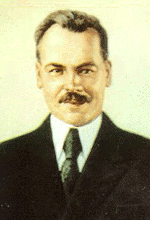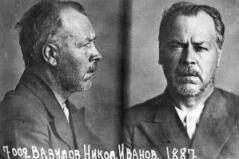Nikolay Ivanovich Vavilov
Plant geneticist, b. 25 November 1887 (Moscow, Russia), d. 26 January 1943 (Saratov, USSR)
 Nikolai Vavilov was the son of a Moscow merchant. In 1911 he graduated from the Agricultural Institute and worked for two years for the Department of Agriculture. In 1913-1914 he studied plant immunity under William Bateson, one of the founders of the science of genetics, at the University of Cambridge, and at the John Innes Horticultural Institution in London.
Nikolai Vavilov was the son of a Moscow merchant. In 1911 he graduated from the Agricultural Institute and worked for two years for the Department of Agriculture. In 1913-1914 he studied plant immunity under William Bateson, one of the founders of the science of genetics, at the University of Cambridge, and at the John Innes Horticultural Institution in London.
On his return Vavilov joined the Saratov Higher Agricultural Courses teaching staff. In 1917 he was appointed Deputy Head of the Bureau for Applied Botany. He worked at the Bureau for the rest of his life and transformed it into the world's largest crop research institute.
In 1918 Vavilov was awarded the title of Professor of the Saratov University. Two years later he was elected head of the Department of Applied Botany and soon moved to Petrograd (today's St. Petersburg) together with his students and associates. In 1924 the Department was transformed into the Institute of Applied Botany and new Crops and occupied the position of the central nationwide institution responsible for collecting the world's plant diversity and applying the results to plant breeding.
In the course of this work Vavilov became the leading plant geographer of his time. He organized and took part in over 100 collecting missions in the major agricultural areas of the world:
Vavilov's major expeditions
1916 |
Iran (Hamadan and Khorasan) and Pamir (Shungan, Rushan and Khorog). |
1921 |
Canada (Ontario) and USA (New York, Pennsylvania, Maryland, Virginia, North and South Carolina, Kentucky, Indiana, Illinois, Iowa, Wisconsin, Minnesota, North and South Dakota, Wyoming, Colorado, Arizona, California, Oregon, Maine). |
1924 |
Afghanistan (Herat, Afghan Turkestan, Gaimag, Bamian, Hindu Kush, Badakhshan, Kafiristan, Jalalabad, Kabul, Herat, Kandahar, Baquia, Helmand, Farakh, Sehistan). |
1925 |
Khoresm (Khiva, Novyi Urgench, Gurlen, Tashauz). |
1926-1927 |
Mediterranean countries (France, Syria, Palestine, Transjordan, Algeria, Morocco, Tunisia, Greece, Sicily, Sardinia, Cyprus and Crete, Italy, Spain, Portugal, Egypt (where Gudzoni was explored on Vavilov's request), Abyssinia (Djibouti, Addis Abeba, banks of Nile, Tsana Lake), Eritrea (Massaua) and Yemen (Hodeida, Jidda, Hedjas). |
1927 |
Mountainous regions in Würtemberg (Germany). |
1929 |
China (Xinjiang - Kashgar, Uch-Turfan, Aksu, Kucha, Urumchi, Kulja, Yarkand, Hotan, Taiwan), Japan (Honshu, Kyushu and Hokkaido) and Korea. |
1930 |
USA (Florida, Louisiana, Arizona, Texas, California), Mexico, Guatemala and Honduras. |
1932-1933 |
Canada (Ontario, Manitoba, Saskatchewan, Alberta, British Columbia) and USA (Washington, Colorado, Montana, Kansas, Idaho, Louisiana, Arkansas, Arizona, California, Nebraska, Nevada, New Mexico, North and South Dakota, Oklahoma, Oregon, Texas, Utah);
Cuba, Mexico (Yucatan), Ecuador (Cordilleras), Peru (Lake Titicaca, Puno Mt., Cordilleras), Bolivia (Cordilleras), Chile (Panama River). Brazil (Rio de Janeiro, Amazon), Argentina, Uruguay, Trinidad and Porto Rico. |
1921-1940 |
European part of Russia and the whole regions of the Caucasus and the Middle Asia. |
Vavilov was particularly interested in the sites of ancient agricultural civilizations. He thought that the mountainous regions of central and western China, together with the adjacent lowlands, constituted the earliest and largest independent centre of the world's agriculture.
As a result of his expeditions Vavilov brought samples of 50,000 varieties of wild plants and 31,000 wheat specimens to his institute in Russia and postulated that a cultivated plant's centre of origin would be found in the region in which wild relatives of the plant showed maximum adaptiveness. These conclusions were summarized in The Origin, Variation, Immunity and Breeding of Cultivated Plants, a work that was translated into English in 1951. In 1920 he expanded the theory, stating that the region of greatest diversity of a species of plant represents its centre of origin. He proposed 8 world centres of plant origin:
- Southeast Asia - coconut, rice, sugar cane
- China - Chinese cabbages, soybean
- India - cucumbers, eggplant, pigeon pea
- Turkey and Iran - wheat, barley, oats, figs
- Mediterranean - almonds, cabbage, olives
- Mexico/Central America - maize, tomato
- Andes/Brazil/Paraguay - peppers, potato, rubber
From 1922 to 1929 Vavilov headed the Institute of Experimental Agronomy which became the V.I. Lenin All-Union Academy of Agriculture in 1930; from 1930 to 1935 he was its first president. From 1930 to 1940 he was director of the Institute of Genetics. From 1931 to 1940 Vavilov was president of the Russian Geographic Society.
Vavilov's work brought him respect and renown around the world; he was elected a member of many academies of sciences and various foreign scientific societies. It also brought him the envy of Trofim Lysenko, a biologist at the Ukrainian All-Union Institute of Selection and Genetics in Odessa and political opportunist who in 1938 rose to the position of president of the Academy of Agricultural Sciences. Lysenko began a campaign against Mendelian genetics and attacked Vavilov as "reactionary, bourgeois, idealist and formalist."
For several years Vavilov defended scientific principles as the basis for socialist development of the USSR against Lysenko's pseudo-science. But under Stalin's government he could not succeed; he was brought to trial and found guilty of sabotage in agriculture, belonging to a rightist conspiracy, spying for England, and a string of other charges, and sentenced to death. His sentence was commuted, but he died in prison in 1943 of malnutrition and was buried in a common prison grave.
Today Vavilov is remembered and honoured by the Russian Society of Geneticists and Breeders, the Institute of General Genetics of the Academy of Sciences, the Institute of Plant Industry, and the Saratov Agricultural Institute. Memorial displays have been opened in Moscow, St.Petersburg, Saratov and Poltava.

Nikolai Vavilov as prisoner in Saratov prison
Although modifications have been made to Vavilov's theory, its central idea that crops have centers of diversity remains crucial for the search of a crop's origin. The fact that plant diversity is not spread evenly around the globe is the basis for current efforts to conserve plant diversity as the basis for future agricultural improvements.
References
Encyclopaedia Britannica 15th ed. (1995) Nikolay Ivanovich Vavilov.
Kurlovich, B. S., L. T. Kartuzova, M. V. Petrova, S. I. Rep'ev, T. A. Voluzneva and T. V. Buravtseva (2004) The significance of Vavilov's scientific expeditions and ideas for development and use of legume genetic resources. PGR Newsletter, FAO (Food and Agricultural Organization of the United Nations) - IPGRI (International Plant Genetic Resources Institute) 124, 23 - 32.
N.I. Vavilov Research Institute of Plant Industry (2004) Biography of Nikolai I. Vavilov. http://www.vir.nw.ru/history/vavilov.htm (accessed 1 October 2004).
home
 Nikolai Vavilov was the son of a Moscow merchant. In 1911 he graduated from the Agricultural Institute and worked for two years for the Department of Agriculture. In 1913-1914 he studied plant immunity under William Bateson, one of the founders of the science of genetics, at the University of Cambridge, and at the John Innes Horticultural Institution in London.
Nikolai Vavilov was the son of a Moscow merchant. In 1911 he graduated from the Agricultural Institute and worked for two years for the Department of Agriculture. In 1913-1914 he studied plant immunity under William Bateson, one of the founders of the science of genetics, at the University of Cambridge, and at the John Innes Horticultural Institution in London.